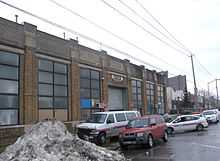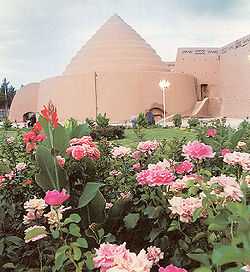Ice house (building)
Ice houses or icehouses (Persian: یخچال "ice pit"; yakh meaning "ice" and chāl meaning "pit") are buildings used to store ice throughout the year, commonly used prior to the invention of the refrigerator. Some were underground chambers, usually man-made, close to natural sources of winter ice such as freshwater lakes, but many were buildings with various types of insulation.
During the winter, ice and snow would be taken into the ice house and packed with insulation, often straw or sawdust. It would remain frozen for many months, often until the following winter, and could be used as a source of ice during summer months. The main application of the ice was the storage of perishable foods, but it could also be used simply to cool drinks, or allow ice-cream and sorbet desserts to be prepared. During its heyday a typical commercial ice house would store 3,000 tons in a 30 feet by 100 feet by 45 feet high building.[1]
History
A cuneiform tablet from c. 1780 BC records the construction of an icehouse in the northern Mesopotamian town of Terqa by Zimri-Lim, the King of Mari, "which never before had any king built."[2] In China, archaeologists have found remains of ice pits from the seventh century BC, and references suggest they were in use before 1100 BC. Alexander the Great around 300 BC stored snow in pits dug for that purpose. In Rome in the third century AD, snow was imported from the mountains, stored in straw-covered pits, and sold from snow shops. The ice formed in the bottom of the pits sold at a higher price than the snow on top.[3]
In the U.K.
Ice was often imported into the UK from Scandinavia up until the 1950s. Usually only large manor houses had purpose-built buildings to store ice. Many examples of ice houses exist in the UK some of which have fallen into disrepair. Good examples of 19th-century ice houses can be found at Ashton Court, Bristol, Albrighton, Bridgnorth, Grendon, Warwickshire, and at Christchurch Mansion, Ipswich, Suffolk, Moggerhanger Park, Bedfordshire Petworth House, Sussex, Danny House, Sussex, Ayscoughfee Hall, Spalding, Rufford Abbey, Eglinton Country Park in Scotland, Parlington Hall in Yorkshire and Croxteth Hall Liverpool. Burghley House, Stamford, Lincolnshire, England.

The ice house was introduced to Britain around 1660. Various types and designs of ice house exist. However, British ice houses were commonly brick lined, domed structures, with most of their volume underground. Ice houses varied in design depending on the date and builder, but were mainly conical or rounded at the bottom to hold melted ice. They usually had a drain to take away any water. It is recorded that the idea for ice houses was brought to Britain by travellers who had seen similar arrangements in Italy, where peasants collected ice from the mountains and used it to keep food fresh inside caves.[4] Ice Houses may also be known as Ice Wells, Ice Pits or Ice Mounds.
Game larders and venison larders were sometimes marked on ordnance survey maps as ice houses.
Bruce Walker, an expert on Scottish vernacular buildings, has suggested that the relatively numerous and usually long ruined ice houses on country estates have led to Scotland's many legends of secret tunnels. The appearance of ice house entrances lends itself to the uninitiated making such deductions, seeing as how ice houses are found in ha-ha walls, house and stable basements, woodland banks, open fields, etc.[5]
In the U.S.
Ice houses allowed a trade in ice that was a major part of the early economy of the New England region of the United States, which saw fortunes made by people who shipped ice in straw-packed ships to the southern U.S. and throughout the Caribbean Sea. In winter months, ice was chopped from a lake surface and often dragged by sled to the ice house. In summer months icemen delivered it to residences in ice-wagons, where it would be stored in an icebox, which was used much like a modern refrigerator.

As home and business refrigeration became more common, ice houses disappeared. The home ice delivery business declined, and was virtually gone by the late 1960s. Smaller ice houses, usually no more than a sawdust pile covered by a makeshift roof or tarpaulin, continued to be maintained to store ice for use in local events such as fairs. Today, most ice for daily consumption is made in a home freezer, while bulk ice is manufactured, distributed and sold like other retail commodities.
The Ice House is a colloquialism for ice hockey rinks in the U.S.
Texas ice houses
In Texas, former ice houses are a cultural tradition. Ice merchants diversified to sell groceries and cold beer, serving as early convenience stores and local gathering places. The widespread US 7-Eleven convenience store chain developed from ice houses operated by the Southland ice manufacturing company in Dallas and San Antonio in the 1930s, which were first known as Tote'm stores.[6] Today many Texas ice houses have converted into open-air bars. In Central Texas, Southeast Texas (especially the Houston area), and the Texas Hill Country, the word "icehouse" has become a colloquialism for an establishment that derives the majority of its income from the sale of cold beer, especially such locally produced labels as Shiner Bock, Pearl, and Lone Star.[7]
See also
- Deep lake water cooling
- Frederic Tudor, the "Ice King"
- Ice
- Ice cutting
- Icehouse at Ambler's Texaco Gas Station
- Refrigerator
- Seasonal thermal energy storage (STES)
- Thermal energy storage
- Yakhchal
References
- ↑ Ward, Tom (1975). Cowtown : an album of early Calgary. Calgary: City of Calgary Electric System, McClelland and Stewart West. p. 192. ISBN 0-7712-1012-4.
- ↑ Stephanie Dalley (1 January 2002). Mari and Karana: Two Old Babylonian Cities. Gorgias Press LLC. p. 91. ISBN 978-1-931956-02-4.
- ↑ James, Peter; Nick Thorpe (1995). Ancient Inventions. Ballantine Books. ISBN 0-345-40102-6.
- ↑ Book of the British Countryside. Pub. London : Drive Publications, (1973). p. 249.
- ↑ Walker, Bruce (1978). Keeping it cool. Scottish Vernacular buildings Working Group. Edinburgh & Dundee. Pages 564–565
- ↑ "7-Eleven, Inc. – Company History". Fundinguniverse.com. Retrieved 2010-08-08.
- ↑ The Kitchen Sisters, NPR, "Texas Ice Houses Melt Away", June 30, 2006. http://www.npr.org/templates/story/story.php?storyId=5522825
Further reading
- Ice Houses of Iran – An Examination of the Evidence
- Gordon Emery – Curious Clwyd (1994) ISBN 1-872265-99-5
A PhD dissertation by Hemming Jorgensen, Copenhagen University, Denmark, August 2010.
Ice and Icehouses Through the Ages by Monica Ellis With a Gazetteer for Hampshire (uk)
The Ice-House of Britain Sylvia P. Beamon and Susan Roaf published 1990 ISBN 0-415-03301-2
External links
-
 Media related to Icehouses at Wikimedia Commons
Media related to Icehouses at Wikimedia Commons - Jamaica Pond Ice Houses and Trade
- Map of ice houses along the Kennebec River, 1891, Maine Memory Network
_Meybod_Iran.jpg)
_Meybod_Iran.jpg)

